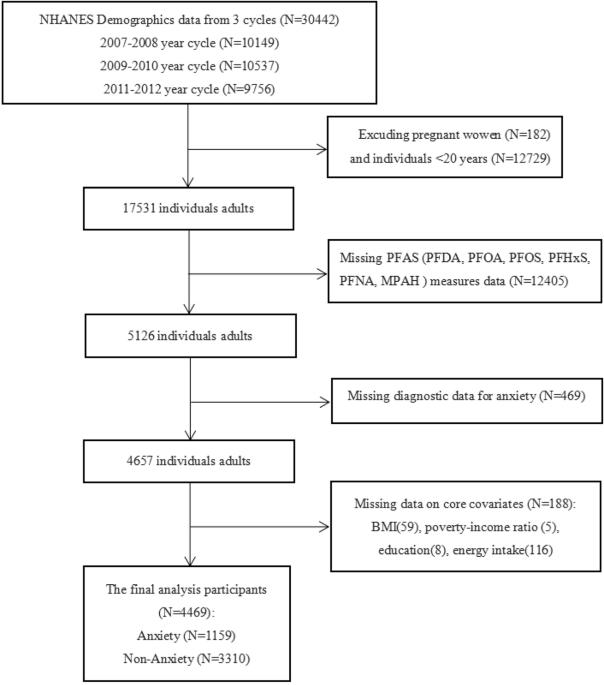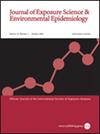美国成年人暴露于单氟烷基和多氟烷基物质混合物与焦虑之间关系的性别特异性
IF 4.7
3区 医学
Q2 ENVIRONMENTAL SCIENCES
Journal of Exposure Science and Environmental Epidemiology
Pub Date : 2025-01-07
DOI:10.1038/s41370-024-00741-3
引用次数: 0
摘要
背景:人们认为暴露于全氟和多氟烷基物质(PFAS)会干扰中枢神经系统,从而可能影响心理健康。关于接触PFAS混合物与人类焦虑之间关系的研究很少。本研究旨在评估成年人单独和联合暴露于PFAS与焦虑之间的关系。方法:数据取自国家健康与营养检查调查(NHANES, 2007-2012)。获取了六种血清PFAS浓度,包括全氟辛酸(PFOA)、全氟壬烷酸(PFNA)、全氟辛烷磺酸(PFOS)、PFHxS(全氟己烷磺酸)、PFDA(全氟癸酸)、Me-PFOSA-AcOH (2-(n -甲基全氟辛烷磺酰胺)乙酸)。焦虑状态是通过参与者的问卷回答来定义的。采用加权logistic回归计算其比值比(OR)和相应的置信区间(95% CI),以评估PFAS暴露与焦虑之间的关系。此外,采用基于分位数的g计算(Qgcomp)和贝叶斯核机回归(BKMR)两种不同的统计方法来研究PFAS混合物对焦虑的总体影响。结果:特定PFAS暴露对焦虑的影响因性别而异。在男性受试者中,PFDA增加1个单位(OR = 0.62;95%ci: 0.44, 0.88), pfoa (or = 0.60;95%ci: 0.41, 0.87), pfna (or = 0.68;95%CI: 0.46, 0.96)浓度与焦虑呈负相关。在女性参与者中,PFOA增加一个单位(OR = 1.50;95%CI: 1.05, 2.14)浓度与焦虑相关。Qgcomp分析表明,PFAS混合物与男性焦虑呈负相关(OR = 0.85;95%CI: 0.74, 0.99),且与女性焦虑呈正相关(OR = 1.16;95%ci: 1.01, 1.33)。BKMR分析表明,PFAS混合物与男性焦虑呈负相关,而与女性焦虑呈正相关。影响:尽管越来越多的研究集中在PFAS和焦虑之间的关系上,但大多数研究都是基于动物观察而不是人群观察进行的,并且PFAS混合物对焦虑的综合影响尚未得到评估。为了解决这些差距,本研究首先探讨了美国成年人中单个PFAS和PFAS混合物暴露与焦虑之间的关系。使用来自国家健康和营养检查调查的数据,我们证明了共同暴露于PFAS混合物与男性焦虑呈负相关,而其与女性的相关性相反。本文章由计算机程序翻译,如有差异,请以英文原文为准。

Sex specificity in associations between exposure to a mixture of per and poly-fluoroalkyl substances and anxiety among US adults
Exposure to per and poly-fluoroalkyl substances (PFAS) is suggested to interfere with the central nervous system that may affect mental health. Studies on the relationships between exposure to PFAS mixtures and anxiety in humans are rare. This study aimed to evaluate the associations between single and combined exposure to PFAS and anxiety among adults. Data were extracted from the National Health and Nutrition Examination Survey (NHANES, 2007–2012). Six serum PFAS concentrations were accessed including perfluorooctanoic acid (PFOA), perfluorononanoic acid (PFNA), PFOS (perfluorooctanesulfonic acid), PFHxS (perfluorohexane sulfonate), PFDA (perfluorodecanoic acid), Me-PFOSA-AcOH (2-(N-methylperfluorooctanesulfonamide) acetic acid). The anxiety state was defined through the questionnaire responses of the participants. Weighted logistics regression was used to calculate their odds ratio (OR) and corresponding confidence interval (95% CI) that assessed the relationship between PFAS exposure and anxiety. Moreover, Two different statistical methods including quantile-based g-computation (Qgcomp), and Bayesian kernel machine regression (BKMR) were employed to investigate the overall effects of PFAS mixtures on anxiety. The effects of specific PFAS exposure on anxiety varied by sex. In male participants, one-unit increase in PFDA (OR = 0.62; 95%CI: 0.44, 0.88), PFOA (OR = 0.60; 95%CI: 0.41, 0.87), PFNA (OR = 0.68; 95%CI: 0.46, 0.96) concentrations were inversely linked to anxiety. In female participants, a one-unit increase in PFOA (OR = 1.50; 95%CI: 1.05, 2.14) concentration was associated with anxiety. Analysis of Qgcomp demonstrated that PFAS mixtures were negatively associated with anxiety in males (OR = 0.85; 95%CI: 0.74, 0.99), and were positively associated with anxiety in females(OR = 1.16; 95%CI: 1.01, 1.33). Analysis of BKMR suggested that PFAS mixtures were negatively associated with anxiety in the males, while its associations with anxiety were positive in the females.
求助全文
通过发布文献求助,成功后即可免费获取论文全文。
去求助
来源期刊
CiteScore
8.90
自引率
6.70%
发文量
93
审稿时长
3 months
期刊介绍:
Journal of Exposure Science and Environmental Epidemiology (JESEE) aims to be the premier and authoritative source of information on advances in exposure science for professionals in a wide range of environmental and public health disciplines.
JESEE publishes original peer-reviewed research presenting significant advances in exposure science and exposure analysis, including development and application of the latest technologies for measuring exposures, and innovative computational approaches for translating novel data streams to characterize and predict exposures. The types of papers published in the research section of JESEE are original research articles, translation studies, and correspondence. Reported results should further understanding of the relationship between environmental exposure and human health, describe evaluated novel exposure science tools, or demonstrate potential of exposure science to enable decisions and actions that promote and protect human health.

 求助内容:
求助内容: 应助结果提醒方式:
应助结果提醒方式:


